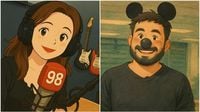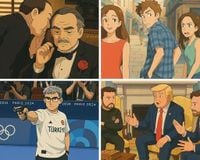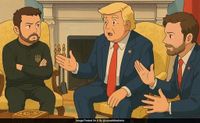A new trend on social media is sweeping across platforms, as users flock to recreate images using artificial intelligence (AI) through ChatGPT. This latest feature, integrated into the updated GPT-4o model, allows individuals to generate illustrations reminiscent of the beloved animation style of Studio Ghibli, the renowned Japanese studio known for classics such as A Viagem de Chihiro and the Oscar-winning O Menino e a Garça.
In just a matter of days, the internet has been flooded with thousands of selfies, pet photos, and memes transformed into vibrant, animated versions, captivating users worldwide. The ease of use, requiring only a simple prompt, has made this tool especially appealing, eliminating the need for complex editing software like Procreate or Photoshop.
OpenAI, the company behind ChatGPT, has seen such a surge in image generation that CEO Sam Altman announced on March 27, 2025, that the high volume is straining the company’s processors. "It's super fun seeing people love images in ChatGPT, but our GPUs are melting. We're going to temporarily introduce some rate limits while we work on making it more efficient," he stated. Despite the overwhelming demand, Altman assured users that the free tier of ChatGPT will still allow for three image generations per day.
However, the rise of AI-generated art has sparked controversy within the animation industry. Notably, Hayao Miyazaki, co-founder of Studio Ghibli, has been a vocal critic of AI in animation. In a 2016 demonstration, he expressed his disdain, saying, "I am utterly disgusted. If you really want to make creepy stuff, you can go ahead and do it. I would never wish to incorporate this technology into my work at all. I strongly feel that this is an insult to life itself." His sentiments resonate with many in the industry who fear that AI-generated art undermines the craft and creativity of traditional animation.
The ChatGPT update not only allows for the recreation of images but also enables users to generate detailed illustrations by providing specific prompts. For example, users can upload a photo and request a transformation into a Studio Ghibli style by detailing the desired background and elements. The process involves preparing a high-quality image, uploading it to the platform, and describing the desired modifications in detail. The platform even encourages users to specify styles, such as requesting a woodland backdrop with vibrant colors and whimsical creatures.
Despite the excitement surrounding this new feature, questions about copyright and intellectual property rights loom large. According to ChatGPT, the images generated are unique and do not directly replicate copyrighted works. "ChatGPT uses the style as inspiration to generate something new, but without replicating specific elements of protected works, such as characters or original scenes," the platform explains. However, the potential for legal complications remains, particularly for those looking to use these images for commercial purposes. Users are advised to consult legal experts to navigate these complexities.
The trend has not only captured the attention of casual users but has also drawn interest from businesses and influencers. As the functionality became widely known, many began using the tool to create promotional content, memes, and artistic interpretations of popular culture. This explosion of creativity has led to what some are calling a "ghibliverse," a term that encapsulates the blend of nostalgia and innovation brought about by this new technology.
Interestingly, the overwhelming popularity of the Studio Ghibli-inspired images has led OpenAI to impose restrictions on the free version of the platform, limiting the number of image generations available to users. This decision reflects the company's need to manage server overload while still providing access to its advanced features.
As the debate over AI-generated art continues, the implications for the animation industry are profound. While some embrace the technology as a tool for creativity, others view it as a threat to traditional artistry. The conversation is ongoing, with many advocating for a balance between innovation and respect for the creative processes that define artistic work.
In a world increasingly influenced by AI, the intersection of technology and creativity raises important questions about the future of artistic expression. As users continue to explore the capabilities of ChatGPT and its image generation features, the dialogue surrounding the ethics of AI in art will likely evolve, reflecting the diverse perspectives of creators, audiences, and industry professionals.
For those interested in trying out this new feature, the process is straightforward. Users can log onto the ChatGPT website or app, upload their chosen image, and enter a prompt such as "Ghiblify this" to receive their transformed artwork. With the ability to generate three images per day on the free tier, many are eager to dive into this new realm of digital artistry.
As we witness the blending of technology with creativity, it remains to be seen how this trend will shape the future of art and whether it will ultimately enhance or hinder the traditional practices that have long defined the animation industry.



